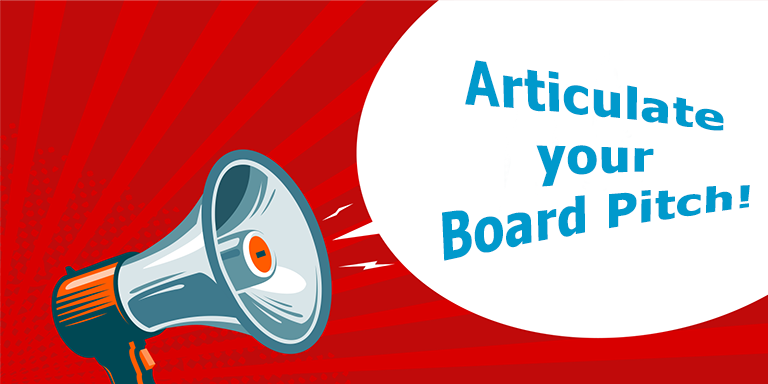Articulate your way to a Board Seat with a powerful Board Value Position

Aspiring board directors need to focus on three pillars to gain a board seat: Aspiration, Articulation, and Application. If you get any of them wrong, your commitment and best-laid plans will only lead to frustration and, often, failure. In this article, I will focus on articulation; it all starts with a powerful Board Value Position (BVP).
Know YOUR Board Value Position (BVP)
Boards consist of members with a variety of skills and experiences, as well as diverse cultures, genders, ethnicities, and ages. Your board value position (BVP) should clearly articulate the individual value you can bring and, more importantly, how you can make a positive impact on a board’s goals. Your BVP is YOUR unique set of skills and experience that you can offer boards and the organizations they serve. Getting it right should set you apart from the other candidates competing for a board seat.
Boards have responsibilities, and directors require the knowledge to make sound decisions. Your BVP should address your knowledge, influence (or connections), and leadership skills. Your influence and connections should reach both internally within and externally from the organization. To demonstrate strong leadership, you must articulate that you can ask the right questions, make tough decisions, provide direction, and take charge in difficult times.
Finally, boards will also seek directors who can fill specific gaps in the board’s overall knowledge and skills. These gaps are considered vital to facing current or potential challenges. If these more specific skills or experiences are not outlined in the selection criteria for the role, you must then be proactive and find out. The first step is to reach out to the role contact and make some enquiries as to what the chair is really looking for. The next step is to conduct research into the board, the organization, the business environment and the competition to identify areas in which you can help. These skills, knowledge and experiences must be incorporated into your Board Value Position.
Articulating YOUR Board Value Position
Once you know your Board Value Position, you must be able to articulate it formally and informally, verbally and on paper. Essentially, you need to be able to answer at any time and in any scenario, “Why do you want to be on their board?” or “Why do you want to be an independent board director?”.
When coaching individuals on articulating their BVP or board pitch, I often refer to the Fundamental Attribution Error (FAE). Cognitive biases such as the FAE result in people making poor first impressions and interactions having little or no lasting impact. The theory suggests that those you are conversing with will develop a general impression of your character based on the situation and limited pieces of information available. If they are not exposed to, or see, the whole picture, their brain by default, revert to making their own judgments based on limited information.
To avoid FAE, you must clearly articulate your Board Value Position. Don’t give people a chance to make biased assumptions. Ensure that the people you speak to and those who read your board application are left with no doubt who you are and what you have to offer as a potential board member.
The various ways to articulate your way to a board seat
Various scenarios and documents provide a platform for you to articulate your way to a board seat. Some are formal, some are informal, some are verbal, and some are written. None of them alone will result in success, so you need to articulate your board value position and variations across all these instances.
Your Board Profile
Your board profile is essentially a formal summary of your BVP. This 5 to 6-sentence statement will address the five core elements that chairs of decision-makers want to see in successful board candidates. These elements are:
- prior governance experience,
- executive skills,
- networks and connections,
- passion and cultural fit.
There are several other elements to consider, including industry experience, governance qualifications and diversity.
Your Board CV
The framework of your board CV is an extension of your BVP. Your Board Profile should be right at the beginning, clearly stating your BVP. The remaining content provides the supporting details, including your executive experience and roles, evidence of your board level or strategic successes, board and committee experience, formal qualifications and relevant memberships.
Your LinkedIn Profile
Your LinkedIn profile is critical to articulate your way to a board seat, but it is often overlooked by aspiring board directors. People commit plenty of time crafting their LinkedIn Profiles to represent them as committed executives, but they fail to articulate their value as board directors or potential board directors.
Articulating your BVP in your LinkedIn profile is critical for several reasons:
- It tells people in your network that you are looking for a board seat. Remember the fundamental attribution error: don’t allow them to make biased assumptions about you.
- Organizations and recruiters use LinkedIn to find suitable board candidates. You will not show up in their LinkedIn searches if your profile does not articulate your Board Value Position.
- It complements and corroborates what you present in your board CV and cover letter. Most recruiters and HR personnel will refer to a candidate’s LinkedIn profile when assessing their board application.
Your Board Cover Letter
The board cover letter is where you must customize your BVP to address the selection criteria and suitability for the board position. A strong BVP and well-constructed board cover letter should clearly separate you from the competition.
Your Board Pitch
You must be able to articulate a condensed version of your board value position in a 30-second-or-less elevator pitch. Suppose you are pitching in an informal setting (at the water cooler) or a more formal one (in a brief call with a recruiter). You must address your expertise, skillsets, industry leadership, and what makes you different. It needs to be short, concise, and, of all things, memorable. Those you are pitching must be able to peg you as a competent board executive, particularly if they have or know of a suitable opportunity. To articulate your way to a board seat, you must have your board elevator pitch down pat.
Your Board Interview
If all goes well, you will be invited to attend a board interview. This is not the time to fail in the articulations of your BVP. If you have made it this far, you and most likely all the other shortlisted candidates have ticked off all or most of the selection criteria. Identifying and articulating your unique value to the board is more critical than ever. Board interview preparation that includes comprehensive research will demonstrate your level of commitment and provide unique opportunities to articulate your value.
Your motivation is important
Articulation includes being careful and thoughtful when expressing your motivations for being or wanting to be a board director. For example, answering the inevitable questions, “Why do you want to be an independent board director?” or “Why do you want to serve on our board?”
Like many, I suspect you will inadvertently tell them about your personal motivations for serving on a board or what attracts you to their organization. A typical response is, “I am semi-retired and have time on my hands. I thought your organization would be a good fit”.
I constantly see individuals focusing on why they should be appointed to a board without considering the motivations of the Chair who will decide to appoint you. Boards and Chairs are passionate about the organizations and causes they represent. Unfortunately, articulating your personal motivations may display a lack of passion for the organization, a lack of understanding of the board and its role, and a lack of commitment to the responsibilities and demands of an independent board director.
Final articulation advice
Here are my final tips to articulate your way to a board seat:
- You MUST know your Board Value Position and be able to pitch it confidently. It will take time to get right, and for most of you, it will require practice.
- Once confident, tell people! You never know who they are connected with or what opportunities they have access to.
- There is no such thing as a static board profile or board pitch. Whilst your core BVP will remain the same, what you articulate should be customized for the situation and organization.
- Always be prepared with a 30-second elevator pitch.
- If you are struggling with your Board Value Position, board profile or board CV, we are here to help. Our Board Appointment Coaching Program PLUS membership package includes a personal board profile and board CV writing service. We will also review every board application before you submit it to give you the best chance to articulate your way to a board seat.
Related Articles
Research can help you get on a board
How to write a powerful Board Profile
About the Author
David Schwarz is CEO & Founder of Board Appointments. He has over a decade of experience in putting people on boards as an international headhunter and recruiter. He has interviewed hundreds of directors and placed hundreds into some of the most significant public, private and NFP director roles in the world.







Responses